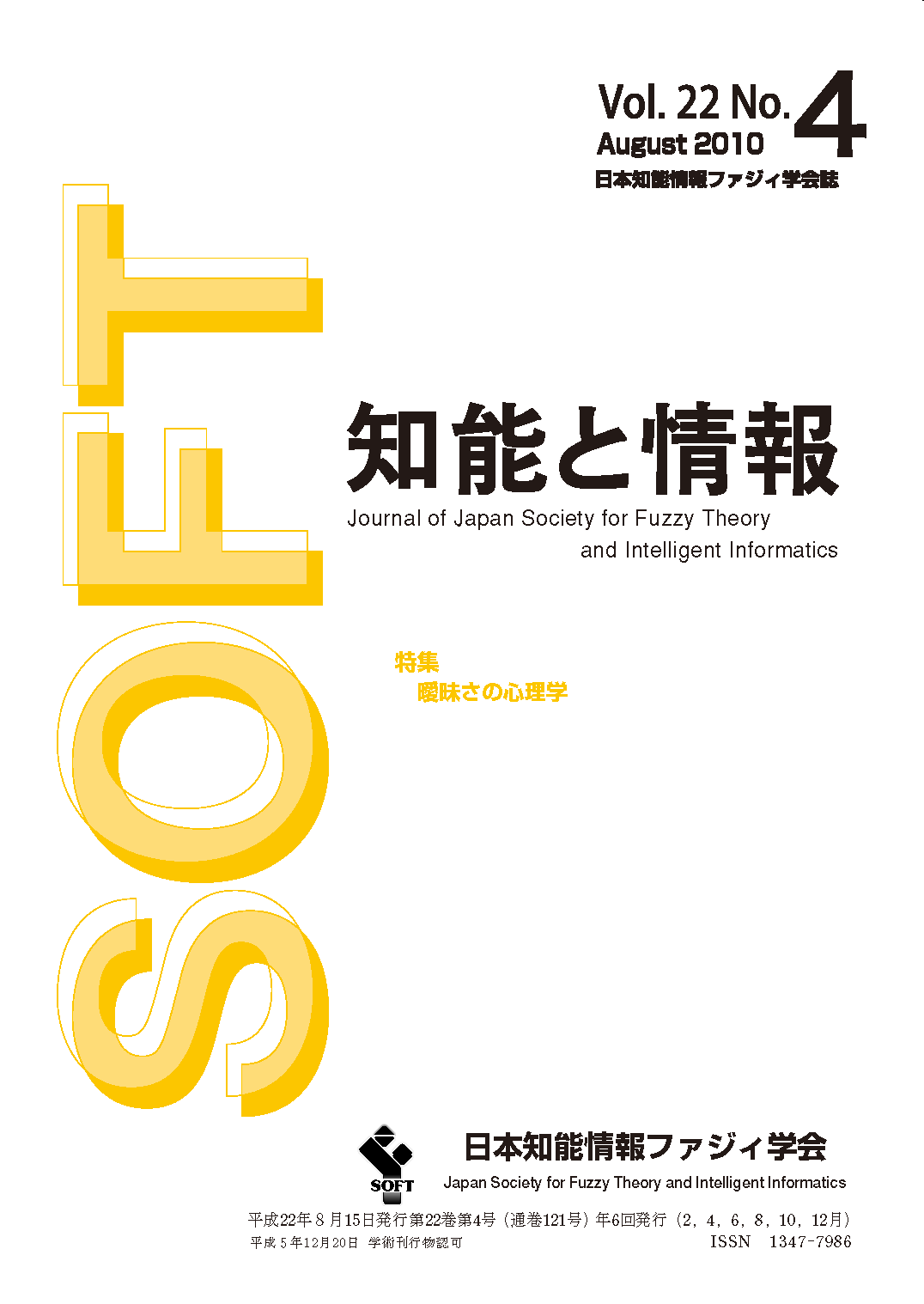Volume 22, Issue 4
Displaying 1-28 of 28 articles from this issue
- |<
- <
- 1
- >
- >|
-
2010 Volume 22 Issue 4 Pages toc-
Published: August 15, 2010
Released on J-STAGE: January 26, 2018
Download PDF (134K)
-
2010 Volume 22 Issue 4 Pages 407
Published: August 15, 2010
Released on J-STAGE: January 26, 2018
Download PDF (125K)
-
2010 Volume 22 Issue 4 Pages 408
Published: August 15, 2010
Released on J-STAGE: January 26, 2018
Download PDF (127K)
-
2010 Volume 22 Issue 4 Pages 409-413
Published: August 15, 2010
Released on J-STAGE: January 26, 2018
Download PDF (420K) -
2010 Volume 22 Issue 4 Pages 414-418
Published: August 15, 2010
Released on J-STAGE: January 26, 2018
Download PDF (344K) -
2010 Volume 22 Issue 4 Pages 419-426
Published: August 15, 2010
Released on J-STAGE: January 26, 2018
Download PDF (2161K)
Special Issue: Psychology of Ambiguity
Original Papers
-
2010 Volume 22 Issue 4 Pages 427-433
Published: August 15, 2010
Released on J-STAGE: November 15, 2010
Download PDF (789K) -
2010 Volume 22 Issue 4 Pages 434-442
Published: August 15, 2010
Released on J-STAGE: November 15, 2010
Download PDF (578K) -
2010 Volume 22 Issue 4 Pages 443-449
Published: August 15, 2010
Released on J-STAGE: November 15, 2010
Download PDF (315K) -
2010 Volume 22 Issue 4 Pages 450-463
Published: August 15, 2010
Released on J-STAGE: November 15, 2010
Download PDF (1267K)
Short Notes
-
2010 Volume 22 Issue 4 Pages 464-470
Published: August 15, 2010
Released on J-STAGE: November 15, 2010
Download PDF (405K)
-
2010 Volume 22 Issue 4 Pages 471
Published: August 15, 2010
Released on J-STAGE: January 26, 2018
Download PDF (133K)
Special Issue: Selected Papers from HM2009
Original Papers
-
2010 Volume 22 Issue 4 Pages 472-480
Published: August 15, 2010
Released on J-STAGE: November 15, 2010
Download PDF (661K)
Short Notes
-
2010 Volume 22 Issue 4 Pages 481-484
Published: August 15, 2010
Released on J-STAGE: November 15, 2010
Download PDF (279K)
-
2010 Volume 22 Issue 4 Pages 485-492
Published: August 15, 2010
Released on J-STAGE: January 26, 2018
Download PDF (593K) -
2010 Volume 22 Issue 4 Pages 493-500
Published: August 15, 2010
Released on J-STAGE: January 26, 2018
Download PDF (1499K)
-
2010 Volume 22 Issue 4 Pages 501-502
Published: August 15, 2010
Released on J-STAGE: January 26, 2018
Download PDF (202K)
-
2010 Volume 22 Issue 4 Pages 503-504
Published: August 15, 2010
Released on J-STAGE: January 26, 2018
Download PDF (369K) -
2010 Volume 22 Issue 4 Pages 505-506
Published: August 15, 2010
Released on J-STAGE: January 26, 2018
Download PDF (300K)
-
2010 Volume 22 Issue 4 Pages 507
Published: August 15, 2010
Released on J-STAGE: January 26, 2018
Download PDF (272K)
-
2010 Volume 22 Issue 4 Pages 508
Published: August 15, 2010
Released on J-STAGE: January 26, 2018
Download PDF (187K) -
2010 Volume 22 Issue 4 Pages 509
Published: August 15, 2010
Released on J-STAGE: January 26, 2018
Download PDF (185K)
-
2010 Volume 22 Issue 4 Pages 510
Published: August 15, 2010
Released on J-STAGE: January 26, 2018
Download PDF (123K) -
2010 Volume 22 Issue 4 Pages 510
Published: August 15, 2010
Released on J-STAGE: January 26, 2018
Download PDF (123K)
-
2010 Volume 22 Issue 4 Pages 511
Published: August 15, 2010
Released on J-STAGE: January 26, 2018
Download PDF (34K) -
2010 Volume 22 Issue 4 Pages 512
Published: August 15, 2010
Released on J-STAGE: January 26, 2018
Download PDF (150K)
-
2010 Volume 22 Issue 4 Pages 513-540
Published: August 15, 2010
Released on J-STAGE: January 26, 2018
Download PDF (710K)
-
2010 Volume 22 Issue 4 Pages bulletin-
Published: August 15, 2010
Released on J-STAGE: January 26, 2018
Download PDF (279K)
- |<
- <
- 1
- >
- >|
